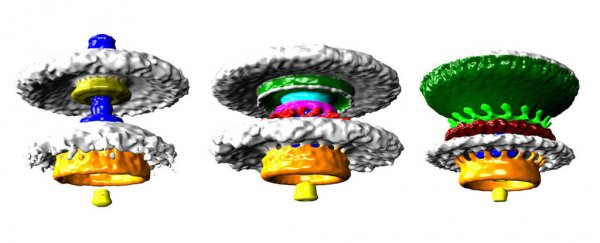The nanoscopic motors that power the movements of bacteria have been imaged in high resolution for the first time, revealing the secrets of how different species of bacterial life aren't all created equally when it comes to swimming ability.
While scientists knew that certain bacteria were superior to others in terms of their propulsion mechanisms, until now it wasn't clear what gave some species their advantage. But by getting up closer than ever to the lifeforms, researchers in the UK have been able to analyse the different kinds of motors that spin their flagella – the slender protein tails that propel many kinds of bacteria.
"For the first time, we have been able to see and explain how these nanoscale molecular machines have evolved in bacteria to colonise new environments," said structural biologist Morgan Beeby from Imperial College London.
Using a newly installed high-powered electron microscope, Beeby's team visualised the minute biological motors in unprecedented detail. The scientists used a technique called electron cryo-tomography to rapidly freeze the bacteria to –180 degrees Celsius (–292 degrees Fahrenheit), allowing them to image the motors in 360 degrees to create the 3D models you can see above.
While the motors across different bacterial species share the same core structure, extra parts in some motors – engine modifications, if you will – give some bacteria the edge.
The motors work on a rotational mechanism, spinning their flagellar tails in a helical, propellor-style motion. According to the researchers, the turning force is produced by a ring of structures called stators that are positioned around the motor. The greater the amount of stators – together with the increased width of the ring in which stators are positioned – leads to higher torque, giving the stators more leverage when rotating the propeller.
"Entire branches of the bacterial family tree have evolved motors with different torques, leading to a diversity of species each geared to their own environment," said Beeby.
For example, in the image above, the motor on the left belongs to Salmonella, offering comparatively low torque. In the middle is a Vibrio motor (related to Vibrio cholerae, the bacterium that causes cholera), offering intermediate power.
On the right, Campylobacter jejuni has high torque and propulsion, thanks to a great number of stators in a wide ring (which help it power through the dense mucus in your stomach lining, giving you gastro).
While the amount of torque differs in each motor, the power of specific bacterial engines has evolved over a very long time to suit the viscous environment in which each particular lifeform lives. According to the researchers, these differences in torque might have started appearing up to 2 billion years ago.
The images, published in Proceedings of the National Academy of Sciences, aren't just important for their wow factor. By understanding more about how these bacteria get around, it could help us come up with ways of disabling motors in bacteria that are harmful to human health.
"It's a fascinating insight into the awe-inspiring diversity of life that has evolved on Earth, and also presents possible drug targets," said Beeby. "We may be able to design drugs that specifically sabotage the flagella only in targeted bacterial species."
